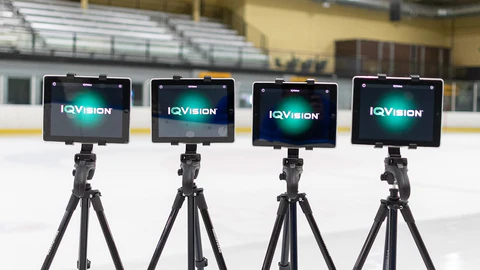Cognitive Training for Hockey: What, Why, and How?
By Hunter Marriott, MSc
Research and Development Consultant
You train your body hard, but are you training your brain too? Incorporating cognitive exercises into hockey training is a topic that is relatively new to researchers but is quickly morphing how athletes train. Something as small as arrows on a screen can potentially have a large impact on your performance.
Motor learning is loosely defined, but covers processes aimed to learn and refine new skills. Since its introduction, there have been numerous theories introduced which claim to be the best way to train in sports, many of which have been heavily disputed by researchers. You might have heard of some of these theories, such as Deliberate Practice Theory – the classic “it takes 10,000 hours of training to master a skill”. Deliberate Practice Theory has since been debunked, as the heavy emphasis on “getting in reps” of a specific movement pattern have been proven ineffective compared to other theories.
Ecological Dynamics is one of the more widely accepted theories, which places an emphasis on the athlete and their relationship to their environment. In Ecological Dynamics, “ecologically valid” drills that closely represent what a player would encounter in game are valued, such as scrimmages. This kind of training allows for the skater’s cognition to be challenged as they’re required to make decisions based on what they perceive from their defender. Ecological training like this, however, may not always be possible for a variety of reasons, like lack of resources. So how can we train more effectively outside of scrimmaging?
Important cognitive traits that separate elite hockey players from their lower-level counterparts include attention and reaction time. Attention is an athlete’s ability to process relevant information to the task and filter out irrelevant and unrelated information, while reaction time is the measure of time to shift their attention to relevant stimuli. While often an “isolated” approach is taken in training (for example, training cognition through computerized tasks and training skills through deliberate practice), combining these approaches into dual-tasking and something called “selective attention paradigms” may improve cognitive and motor outcomes more significantly.
Selective attention paradigms date back to 1994 when Susan G. Zeigler created a method called “attentional shift training” in which soccer players were instructed to complete various movements corresponding to letters, shapes, numbers, and colors printed on cards. Methods like this led up to the computerized methods of today in apps like IQVision where similar cues flash on screen to prompt decision making for athletes. These prompts allow the player to train their attention and decision-making skills through visual cues, requiring them to filter out any irrelevant information and/or quickly shift their attention. For example, skaters can be taught to ignore irrelevant information through the display of simultaneous prompts such as an arrow and a color, where only the color is meaningful information for a change of direction task.

Visual and cognitive training for ice hockey players | Apex Hockey
Dual tasking involves completing a motor task, such as a stick handling drill, and adding a cognitive task to distract with irrelevant information. These could be as simple as reciting the alphabet backwards or mental math. While these approaches are commonly used in sport as an additive approach (to enhance/optimize existing cognitive functions), there has been more evidence to show the importance of dual-task training for restorative functions in injury rehabilitation in athletes who have sustained concussions, ACL reconstruction, and more.
While general, nonspecific cognitive stimuli such as arrows, colors, numbers, and more may not be as ecologically valid as human stimuli where players are required to adapt to the movements of their defender or teammates, they are far more accessible. Visual stimuli allow for cognitive and sport-specific training to be coupled while training individually and in small groups, with little equipment and cost associated with the training. Experts have recommended general visual stimuli as a training tool in sport over other methods such as human stimuli or video stimuli due to the purposely designed equipment, accessibility, and logistical efficiency associated with these visual cues compared to the other methods.
To increase the ecological validity of visual cues, simple adjustments can be made like having the cues at eye level, as hockey players don’t often look at the ice to gather information. Another important consideration to maximize the benefits of cognitive training in hockey is skill level of the player. Superior performance has been shown in athletes with the use of adaptive difficulty, meaning the cognitive demand of an activity should increase with skill level in order to properly challenge the skater. While younger, less experienced athletes may benefit from something like arrows flashing on a screen to tell them when to change direction, elite athletes require a more intensive approach with irrelevant information to filter out and a less direct signal than an arrow to change direction.
While there’s still much to be learned about motor learning for athletes, this kind of visual training is a great supplement to traditional practice techniques to improve performance. In the future, more theories may come to light that show better ways to train. Until then, training both your brain and body through dual-tasking and selective attention paradigms is something that should be seriously considered to improve your game.
Research of Interest
Paul, D. J., Gabbett, T. J., & Nassis, G. P. (2016). Agility in team sports: Testing, training and factors affecting performance. Sports Medicine, 46(3), 421-442.
Walton, C. C., Keegan, R. J., Martin, M., & Hallock, H. (2018). The potential role for cognitive training in sport: more research needed. Frontiers in psychology, 9, 1121.
